9 Minuten Lesezeit
Lily of the valley (Convallaria majalis) has a fragrant scent – but its poisonous leaves are easily mistaken for ramsons! The white bell-shaped flowers stand out from the green mass.
~ Poisonous plant of the year 2014 ~
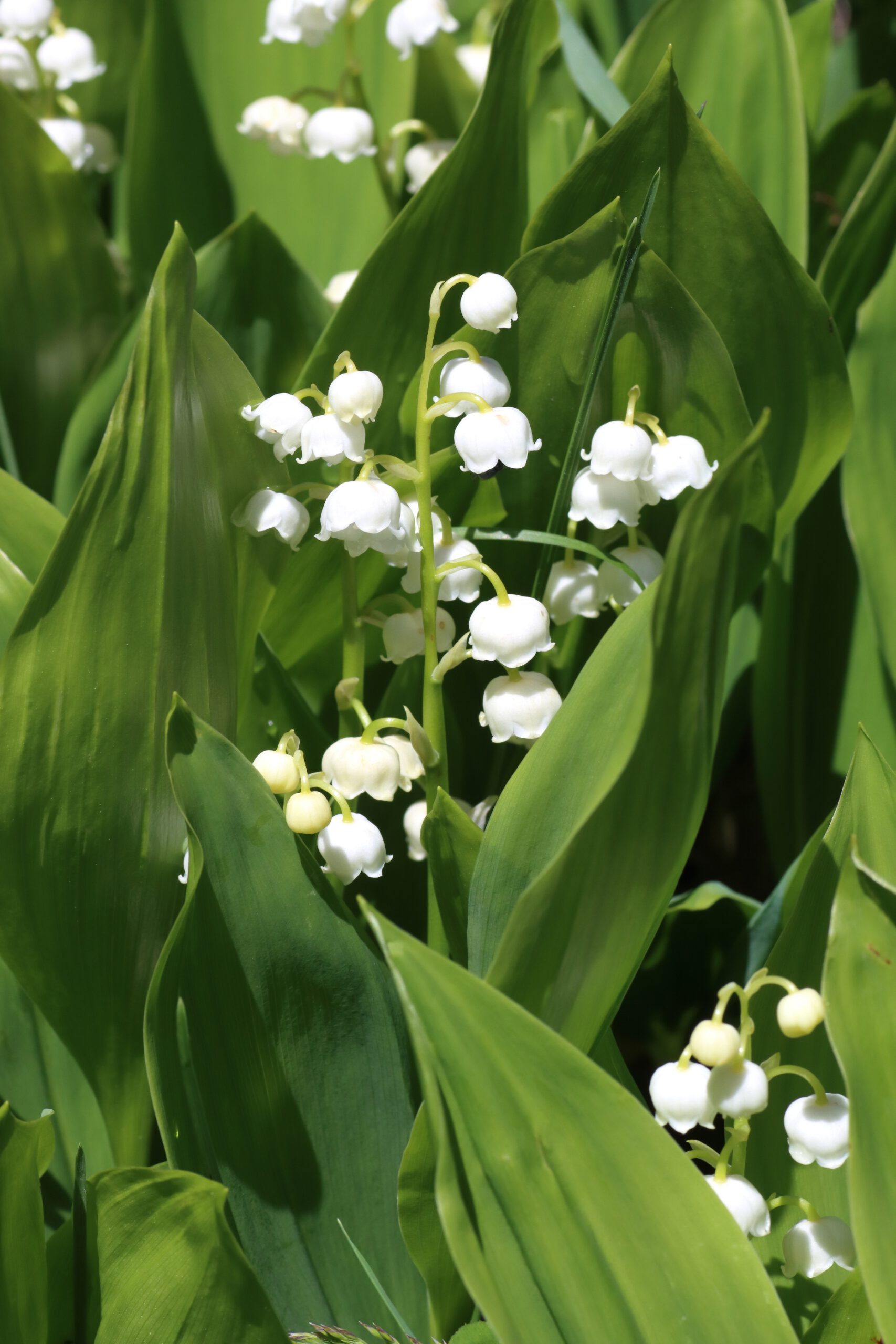
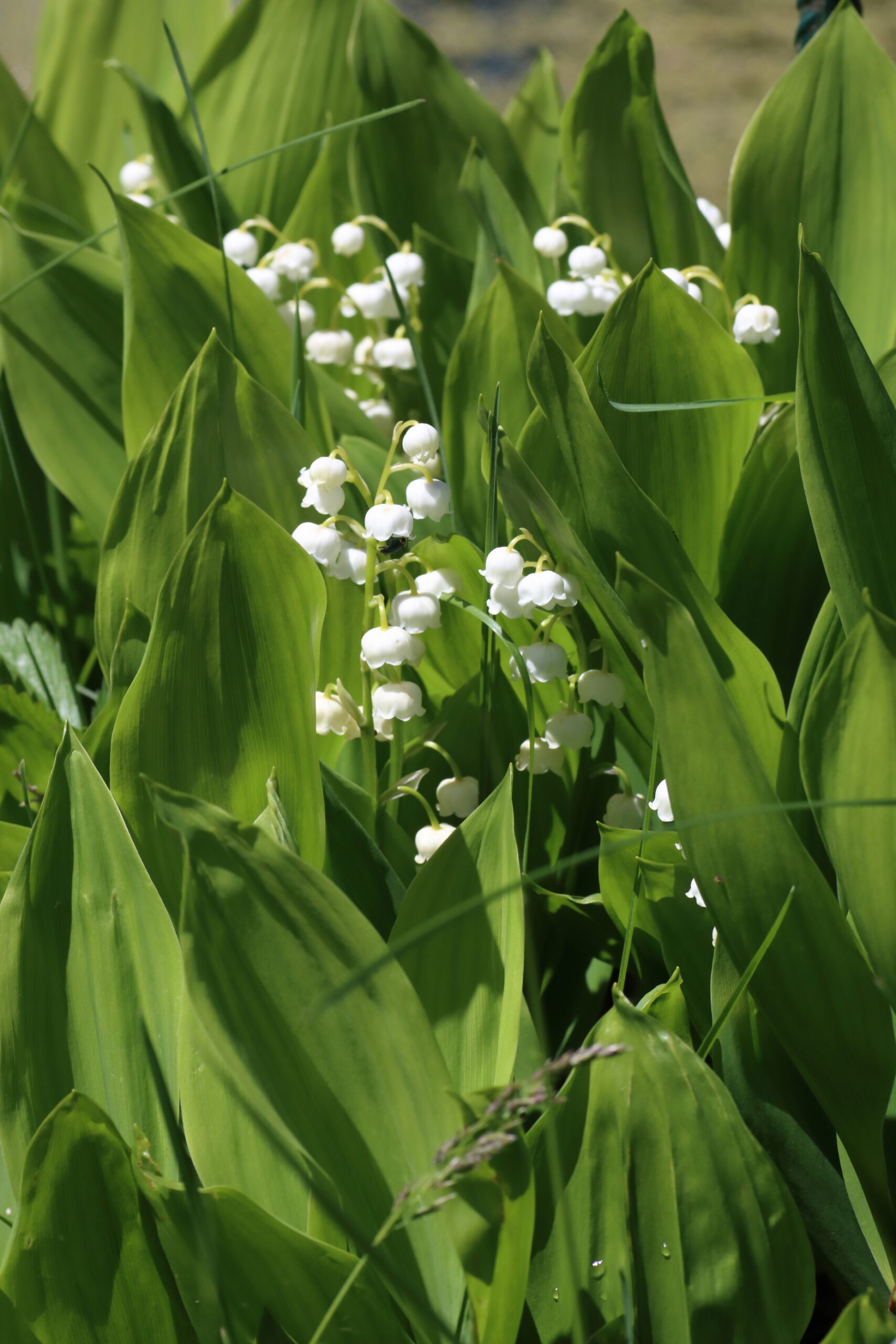
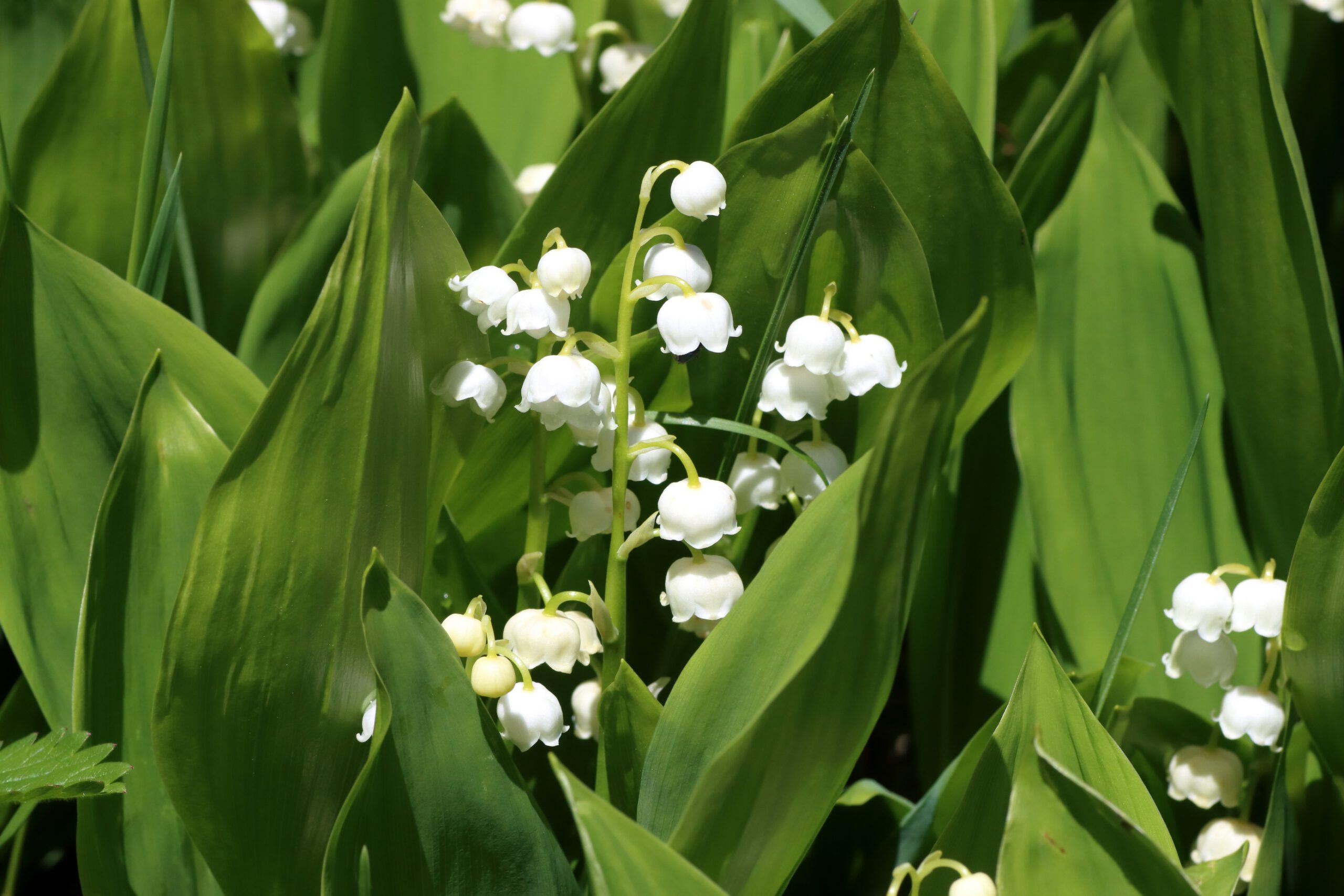



~ highly poisonous plant ~
Occurrence and distribution: Lily of the valley occurs in oak, beech and pine woods and tall grass meadows. Larger stands are often found in sparse broadleaf woods. It is also sometimes found amongst bushes and under shrubs. It prefers calcareous soils and is therefore sometimes considered an indicator plant. In the Alps it grows at altitudes of up to 2,200 metres. It is native to most of Europe and parts of Asia. In North America it is considered a ‘neophyte’. Southern European populations are usually only found in the mountains, as they prefer a temperate, cooler climate. In the vicinity of gardens and parks, the Lily of the Valley is often considered to be a ‘cultivated form’.
Plant description
Growth form: Lily of the valley is a perennial with an underground stem. This can develop more side shoots. This results in larger clumps of the plant.
Leaves: In spring two basal leaves develop on an elongated stalk. When young they are rolled up in a sack shape. Later they unfold. The leaves are broadly lanceolate and can be up to 22 cm long. If the leaves are damaged, they have a grassy smell. The edges of the leaves are straight.
Characteristics for distinguishing the wild garlic and the lily of the valley
Wild garlic
- distinct garlic odour
- soft leaves
- only one leaf per stalk, green colour
Lily of the valley
- grassy odour
- firm leaves
- two leaves per plant with reddish colouring on the stem
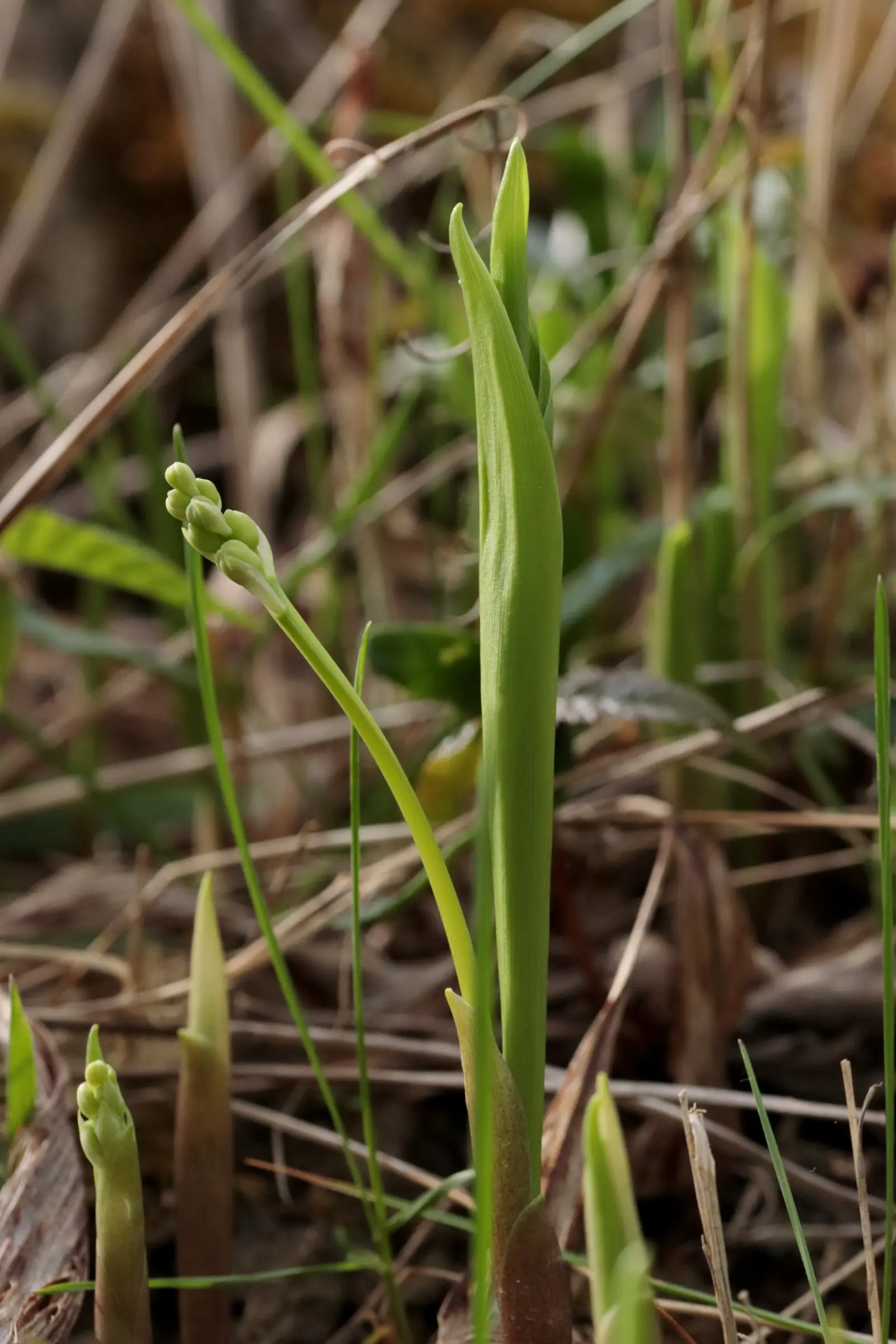
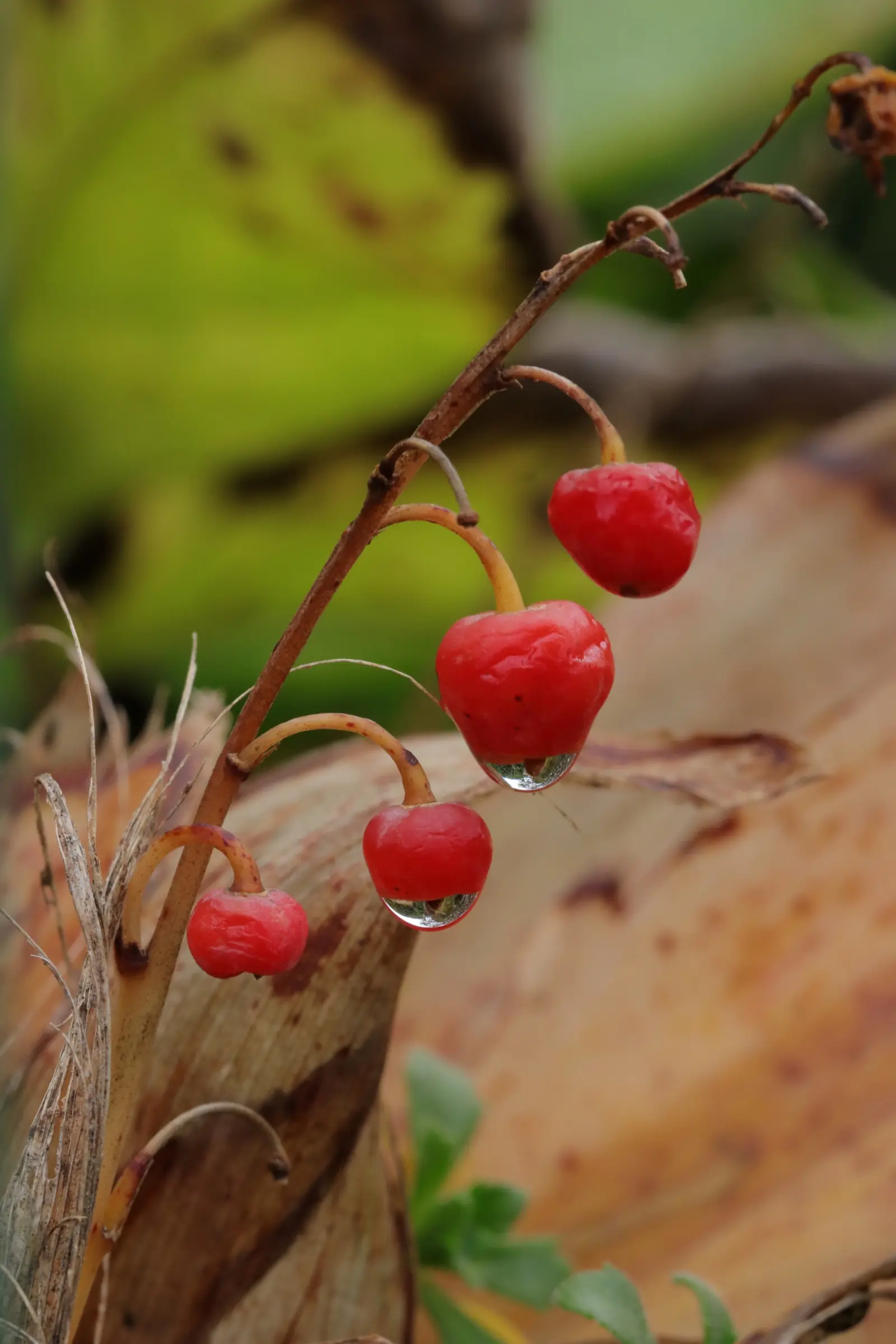
Click here to download a PDF with the distinguishing features.
Flowers: The flowers are arranged in an alternate raceme on angular stalks. The perigone is bell-shaped and consists of six fused petals. These are only about 5 to 9 mm across. The edges of the petals are slightly curved upwards. The petals are white. There are 5 to 13 flowers per spike. The flowers do not produce nectar. There are typically two rings of three stamens inside the flower. The pale yellow to greenish stigma is in the centre of the flower. They are therefore hermaphroditic and can pollinate themselves to some extent. The scent of the flowers is beguiling to insects and humans. The flowering season lasts from May to June.
Fruit: The individual fruits consist of a red-orange berry. They form directly on the leafless stems after flowering. Fruits develop from July to August. They ripen in August and September. Each berry contains between two and six seeds.The seeds are mainly dispersed by animals, including birds. Blackbirds and thrushes in particular are responsible for seed dispersal. The seeds need a humus-rich, loose soil.
Poisonous plant – handling advice
Toxicity of the plant: The plant is highly poisonous and can be fatal under certain circumstances. The glycosides in the leaves and berries are used in pharmaceutical preparations as a heart remedy. Self-medication is strongly discouraged! The berries are particularly dangerous for children. They can be eaten quickly and lead to poisoning. Lily of the valley is also highly toxic to animals such as goats and pigs.
Handling instructions: Gloves should be worn whenever possible when handling the plant. Touching the leaves is not poisonous, but picking them can release poisonous sap.
Ingredients of the plant: The plant contains digitalis glycosides, asparagine, flavonoids and saponins. The digitalis glycosides are comparable to those found in foxglove and have a similar effect. The toxins are not destroyed by drying. Specifically, the plant contains the following toxins:
- glycosides: convallatoxin, convalloside, convallamarin (they act like cardiac glycosides)
- saponins: convallarin, convallaric acid
- toxic amino acid: azetidine carboxylic acid
source: Clinitox Datenbank
LD50: The lethal dose for humans is unknown. In cats it is approximately 0.07-0.08 mg/kg convallatoxin. Cases of poisoning in pigs, rabbits, poultry, dogs and cats are known.
Symptoms of poisoning: Poisoning by the plant causes nausea, vomiting, visual disturbances and convulsions. Severe poisoning can lead to cardiac arrhythmia and death from cardiac arrest. However, severe poisoning is rare because the toxins are poorly absorbed by the body. Even so, don’t make a small salad out of the plant. However, fatal poisonings have already been reported, mainly as a result of its being mistaken for wild garlic.
First aid in case of poisoning: If large quantities are swallowed, consult a doctor. In case of doubt, contact the poison control centre.
Use of the plant
Industrial use of the plant: The flowers of the lily of the valley were once used in the production of perfume because of the essential oil they contain. However, the oil is now mostly produced synthetically on a large scale.
Cultivation areas of the plant: Until 1945 the town of ‘Drossen‘, now Ośno Lubuskie (in Poland), was known as the town of the Lilly of the Valley. The gardener Max Friedrich grew large quantities of lily of the valley there as early as 1879. “May flowers” were sold from the town all over the world. The plants were also used for medicinal purposes. After the end of the Second World War, this tradition was abandoned.
Ancient use as a medicinal plant: The plant has been used in folk medicine since the Middle Ages to treat conditions such as epilepsy, stroke and heart failure. However, due to the large number of poisonous glycosides, its use as a medicinal plant in its own right is not recommended. In the past, the individual plant constituents were sold in pharmacies as Radix Convallariae, Herba Convallariae and Flores Convallariae. In pharmacies, the plant is used to make ready-to-use preparations for heart problems. However, these contain a precisely researched dose of glycosides.
Folk names & origin of names
Folk names: The lily of the valley is known as the (fragrant) May flower, May lily or Mairöschen / Mairösle (May rose), Maienriesli. In Swabian, the plant is known as ‘Maieblümle, Maiaglöggle and Maiarösle’. The name ‘Maiblume’ (May flower) and its variations are mainly derived from the plant’s flowering time. The flowers open in May. Due to its flower shape (bell-shaped), it bears a certain resemblance to our native lilies and orchids. This is said to have given rise to the popular german name ‘Maililie’, which is also reflected in the English name. The name ‘Mairösle’ comes from the Alemannic language area. It refers to the flowering time in May and the distant appearance of a rose.
Origin of the botanical name: The genus name ‘Convallaria’ originally derives from the latin word ‘convallis’. This means ‘valley basin’ in English – a reference to the plant’s habitat. The Latin name is often translated as ‘lily of the valleys’. The English name of the plant ‘Lily of the valley’ is also derived from this.
Endangerment of the plant
Status on the Red List: The plant is a protected species in Germany. It may therefore not be picked or dug up under any circumstances. The lily of the valley is currently on the Red List of endangered species in Germany.
Distribution-Codes: A, AV, M1, M2, F, K